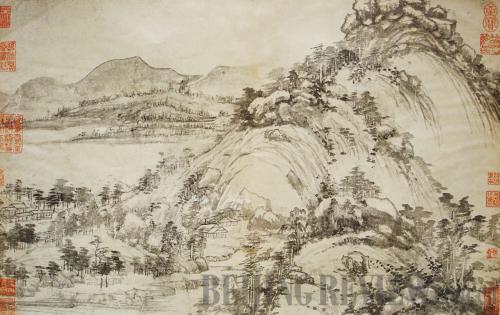|
 |
|
INCOMPLETE TREASURE: Part of the painting Dwelling in the Fuchun Mountains housed in the Zhejiang Provincial Museum (FILE) |
Chinese Premier Wen Jiabao told a story about a famous Chinese painting Dwelling in the Fuchun Mountains at a press conference after the Third Session of the 11th National People's Congress in March 2010. Half of the painting is kept in a museum in Hangzhou, capital of Zhejiang Province, while the other half is housed in the "National Palace Museum" in Taiwan. Wen said he hoped one day the two pieces of the painting will be brought together again—and expressed the same wish not only for the painting but also for the people on both sides of the Taiwan Straits.
In the near future the two parts will come together actually for the first time since they were torn apart. The painting is about to be displayed in its entirety at an exhibition in the "National Palace Museum" in Taipei from June 1 to September 25.
The idea of reuniting the painting brewed as early as 1998. But, "the good wish could not be achieved because of the cross-Straits relations at that time," said Chen Hao, Curator of Zhejiang Provincial Museum, where the first half of the painting is housed.
Academically, it is significant to reunite the painting. More importantly, the painting is imbued with too many stories of the vicissitudes of society, he said. "It is the epitome of the history of China. The display in its entirety embodies the strong wish of people across the Straits for the reunification of the country."
"The two pieces of Dwelling in the Fuchun Mountains are like siblings. They are of one blood," said Shan Guoqiang, a research fellow with the Palace Museum in Beijing.
Fu Shen, a former professor of "National Taiwan University," who has carried out extensive research into the painting for a long time, says there are many coincidences in the painting's history. The painting was completed in 1350, a Year of Tiger according to the lunar calendar. It was burnt and torn apart in 1650, also a Year of Tiger. In 2010, another Year of Tiger, when it was talked about by Premier Wen, the famous painting has once again aroused the public's interest. It has become a cultural symbol connecting both sides of the Taiwan Straits.
Masterpiece
Dwelling in the Fuchun Mountains, created by well-known painter Huang Gongwang (1269-1354) of the Yuan Dynasty (1206-1368), is considered a masterpiece of traditional Chinese landscape paintings. The painting is regarded as one of the top 10 most famous classical art works of China, and its unique style and creative techniques have had and are still exerting a great influence on later generation painters.
The entire original painting was 848 cm in length, and portrayed the early autumn scenery along the Fuchun River in east China's Zhejiang Province. Huang began to work on the painting in 1348 and it took him about three years to complete.
Huang is one of the four most famous painters of the Yuan Dynasty. He was a low-rank official in Dadu (today's Beijing), then capital of the dynasty, and was imprisoned as a result of an unjust sentence. After he was released, he began traveling around the country and drew pictures to amuse himself. In his 50s, Huang became a hermit living along the Fuchun River area where he began to learn from a painting master and dedicate his life to Chinese landscape painting.
In his late 70s, at the invitation of one of his friends, Huang began to draw the grand work, Dwelling in the Fuchun Mountains. Huang lived in a cottage on the Fuchun River bank, observing the scenery around the river day by day, gradually outlining all the scenic views in his mind. The creation took several years, and shortly after Huang finished it, he passed away.
| 